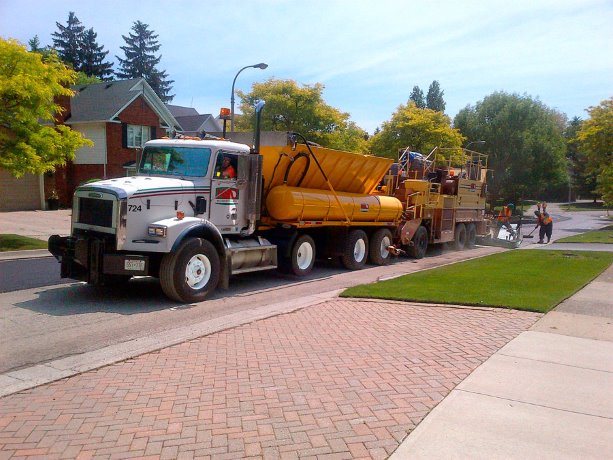Slurry seals that provide extra sealant to pavement are a great way to save municipal dollars and extend highway life, state several industry experts.
However, their use in Ontario seems to be mostly relegated to rural communities. Even in rural districts its use tends to be on more isolated roads, often in a strategically rational way to get the most bang out of municipal public works budgets.
"It’s a good tool, it certainly is, when you compare it to the cost of rehabilitation," said Tom Bateman, an engineer for the County of Essex, who is also a former president of the Ontario Good Roads Association.
Bateman recently spoke before municipal council trying to impress the fact this technique offers major savings.
"Instead of waiting for roads and bridges and culverts to deteriorate to the point where you’ve got to replace them or do major rehabs, spending money timely on preservation techniques pays long dividends," he explained.
Costs are in the $2.50 per square metre range in southwestern Ontario and $3 to $4 elsewhere in the province, explained Nicholas Cifelli of Miller Paving in Stouffville. That’s compared to much more money for new hot mix paving.
"It’s kind of hard to compare because this is all done in square metres and hot mix is usually sold by the tonne," Cifelli said.
"But if you do some quick math and your hot mix is $90 per tonne, to do a two-inch lift is $11 a square metre, just for the material, and then your milling would be another $3 or $4 on top of that, whereas a slurry seal is a fraction of that."
Some communities let their original hot mix roads deteriorate so much they have to be milled and replaced with hot mix again. Slurry seal works best to preserve a road in good or decent condition.
"A slurry seal is ideally applied earlier in a road’s life to keep a good road good," Cifelli said. "Instead of shaving and paving, say at 10 years, you’d apply a slurry seal at five years."
This would seal the pavement, restore friction and improve esthetics for four to seven years.
From a public works policy perspective, preserving pavement is not flashy and the public optics may not seem great, especially when motorists want fast action repairing badly potholed roads first, he added.
"A lot of times, a five- to seven-year-old road doesn’t look that bad," Cifelli said, and therefore taxpayers may question the expense. But, it’s all about having a "preservation mindset."
Slurry seals are a mix of emulsified asphalt, water, aggregate and cement powder. The mix is designed in a lab and produced and placed by a self-propelled or truck-mounted continuous paving unit.
The components are mixed in a pug mill and discharged into a spreader box that applies the seal over the lane width, spreading a very thin surface layer. Typically, a coat will be five to six millimetres thick.
There are three slurry seal gradations: fine, general and coarse. Another variation is microsurfacing, which has advanced polymer additives (and is also more expensive) but can be applied thicker and in multiple lifts.
"If the road has some rutting you can apply one layer to fill the rut that sets up within the hour, followed by a top coat to give a level, finished surface," Cifelli said.
Roadways can be treated multiple times with the seals, unless the road develops a base problem or traffic increases to a point where the pavement breaks down. Snow plows can also scuff the seal off over time. As well, damage like alligator cracking may render the technique ineffective.
"It (slurry seals) doesn’t add any structure to the road, it doesn’t do any base repairs, so you need a pavement that’s in good or decent shape," Cifelli said.
Slurry seal benefits include preventing water from penetrating the surface and providing better surface traction.
"The only difference you notice is driving on it will be a little noisier," Cifelli said. "Otherwise, it looks like new hot mix."
Jay Tiernay, executive director of the Ontario Good Roads Association, conducted an informal survey of some board members and found the technique doesn’t seem to be done much in urban areas. Toronto and Brampton, for example, don’t use it at all.
"I think you’ll find they’re more used in the rural areas," he said.
Chris Traini, an engineer for Middlesex County near London, said in an email that slurry seals "are one of the many options available in the municipal tool box for pavement rehabilitation (and are) especially effective for extending surface life of pavements for two to five years which, for example, could be helpful in co-ordinating underground utility replacement or surface asphalt."






Recent Comments
comments for this post are closed